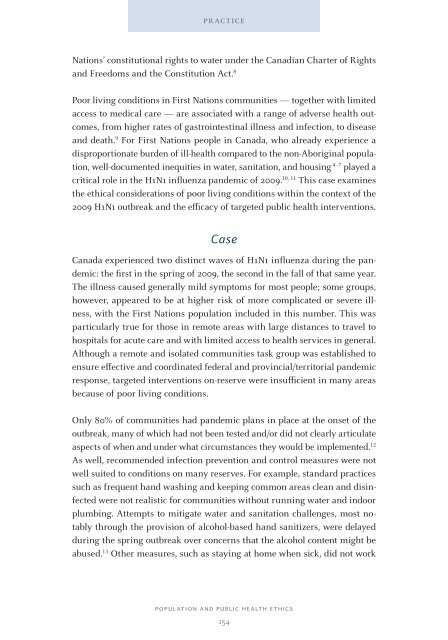PoPulationand Public HealtH etHics
PoPulationand Public HealtH etHics
PoPulationand Public HealtH etHics
Create successful ePaper yourself
Turn your PDF publications into a flip-book with our unique Google optimized e-Paper software.
practice<br />
Nations’ constitutional rights to water under the Canadian Charter of Rights<br />
and Freedoms and the Constitution Act. 8<br />
Poor living conditions in First Nations communities — together with limited<br />
access to medical care — are associated with a range of adverse health outcomes,<br />
from higher rates of gastrointestinal illness and infection, to disease<br />
and death. 9 For First Nations people in Canada, who already experience a<br />
disproportionate burden of ill-health compared to the non-Aboriginal population,<br />
well-documented inequities in water, sanitation, and housing 4–7 played a<br />
critical role in the H1N1 influenza pandemic of 2009. 10, 11 This case examines<br />
the ethical considerations of poor living conditions within the context of the<br />
2009 H1N1 outbreak and the efficacy of targeted public health interventions.<br />
Case<br />
Canada experienced two distinct waves of H1N1 influenza during the pandemic:<br />
the first in the spring of 2009, the second in the fall of that same year.<br />
The illness caused generally mild symptoms for most people; some groups,<br />
however, appeared to be at higher risk of more complicated or severe illness,<br />
with the First Nations population included in this number. This was<br />
particularly true for those in remote areas with large distances to travel to<br />
hospitals for acute care and with limited access to health services in general.<br />
Although a remote and isolated communities task group was established to<br />
ensure effective and coordinated federal and provincial/territorial pandemic<br />
response, targeted interventions on-reserve were insufficient in many areas<br />
because of poor living conditions.<br />
Only 80% of communities had pandemic plans in place at the onset of the<br />
outbreak, many of which had not been tested and/or did not clearly articulate<br />
aspects of when and under what circumstances they would be implemented. 12<br />
As well, recommended infection prevention and control measures were not<br />
well suited to conditions on many reserves. For example, standard practices<br />
such as frequent hand washing and keeping common areas clean and disinfected<br />
were not realistic for communities without running water and indoor<br />
plumbing. Attempts to mitigate water and sanitation challenges, most notably<br />
through the provision of alcohol-based hand sanitizers, were delayed<br />
during the spring outbreak over concerns that the alcohol content might be<br />
abused. 13 Other measures, such as staying at home when sick, did not work<br />
PoPulation anD <strong>Public</strong> <strong>HealtH</strong> <strong>etHics</strong><br />
154
















